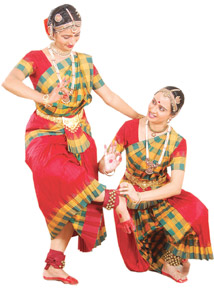Earliest masters of Bharatha Natyam
Subashini Pathmanathan
Nattuvanars were the real mentors of Bharatha Natyam. But
unfortunately the present generation Bharatha Natyam students have lost
the opportunity to learn Bharatha Natyam under them. They were the
masters in their field. They not only taught dance to the students but
they also imparted and developed the overall self confidence of their
students. The rapport between the guru and the shisyas were very smooth.
 |
|
Early
masters made sure they
taught this art in its purest form |
They were very firm and strict with the students during the time of
their coaching. They were strict disciplinarians and guardians of their
own chosen art field. Their imparting method was totally based on
individual coaching. They didn't show much interest to take group
classes. These traditional gurus cultivated deep involvement and
dedication among their students. Lack of theoretical knowledge in the
dance field was the main drawback among the students, who learnt dancing
under these traditional Gurus. They only paid attention to develop the
practical side of the dance.
Community structure
The Nattuvanar community belongs to the IsaiVellalar caste, who were
the mentors of the art. The Devadasis are the female members of this
community and Nattuvanars are the male members of this community.
Earlier the members of the community were serving at the temples, by
preserving and protecting various temple art forms. The Nattuvanar
taught Sathir dances to their female members of their society
(devadasis). The male members of the Nattuvanar community are still the
Thavil players (drum players), and the Nathaswara players. They are
still serving at the temples, as the temple musicians for the Nithya
(daily) and Nimithya (occasional festivals) Kiriyas of the temples. Here
we have to remember that Bharatha Natyam evolved out of temple rituals.
These traditional Gurus' only aim was to train the students or to
coach the students as outstanding and excellent dancers.These Gurus
never adopted any commercial tactics to pick up or to develop their
profession. They always built-up their reputation steadily through their
productions. They never went behind the cheap publicity. Their life
style was simple and throughout the life they dedicated their whole life
for the betterment of music and dance.
Many of the present dance Gurus learnt dancing mainly in different
institutions or studied under different Gurus who had already been
trained in dance by institutions. That's why at present the Bharatha
Natyam world has changed into a mechanical dance form. Lack of grace and
lack of high degree of facial expressions are the common features of the
present Bharatha Natyam. Unfortunately majority of the present
generation audience and the art lovers have lost the opportunity to view
the pure typical classical Bharatha Natya programmes.
Traditional teachers
The experience of learning dancing at the institution level is
entirely different from the experience of learning dancing under the
traditional Gurus directly. Under the traditional Gurus one imbibed the
art and the shishyas learned the art throughout under the able guidance
of one and the same Guru. These traditional gurus gave rigid training in
dancing by moulding their students to dance perfectly in the concerts.
The dancers trained by the traditional Gurus danced with full essence of
aesthetic values and creativity. The students were encouraged to dance
and used their full self-creativity and they were also encouraged to use
the expressions of their own to the maximum extent.
Learning dancing at an institution provides an opportunity for one to
learn the dance under a systematic manner to a selective, fixed and
defined syllabus within a certain limited time framework. Anyhow the
students are supposed to study dance at the institutions under different
teachers, in different stages and in different years. Individual talents
are not much recognized at these institutions.
Under the well defined syllabus the attention at the institutions are
paid, both to the practical and the theoretical aspects of the art.
After the completion of the course, degrees or diplomas are awarded to
the students. Sometimes this attitude might emasculate the art and on
the other hand it might also encourage the craze for certificates among
the student community.
The Nattuvanars like Meenakshi SunderamPillai, Ella Pillai,
Thandayutha PaniPillai were some of the outstanding Gurus of the
Pandanallur School. And Vazhuvoor RamiahPillai, and S. K Rajaratnam
Pillai were some of the outstanding gurus of the Vazhuvoor School.
Teaching dancing in the society added a status and respect for the
traditional Nattuvanars. Earlier many local and foreign students took up
residence at the Nattuvanar homes to learn the art.
This was the main cause for the growth of Guru Shisyaparampara
(generation) in the dance world. The tradition of those who reside at
the residence of the guru by serving the guru and studying is known as
Guru Kula method.
|







